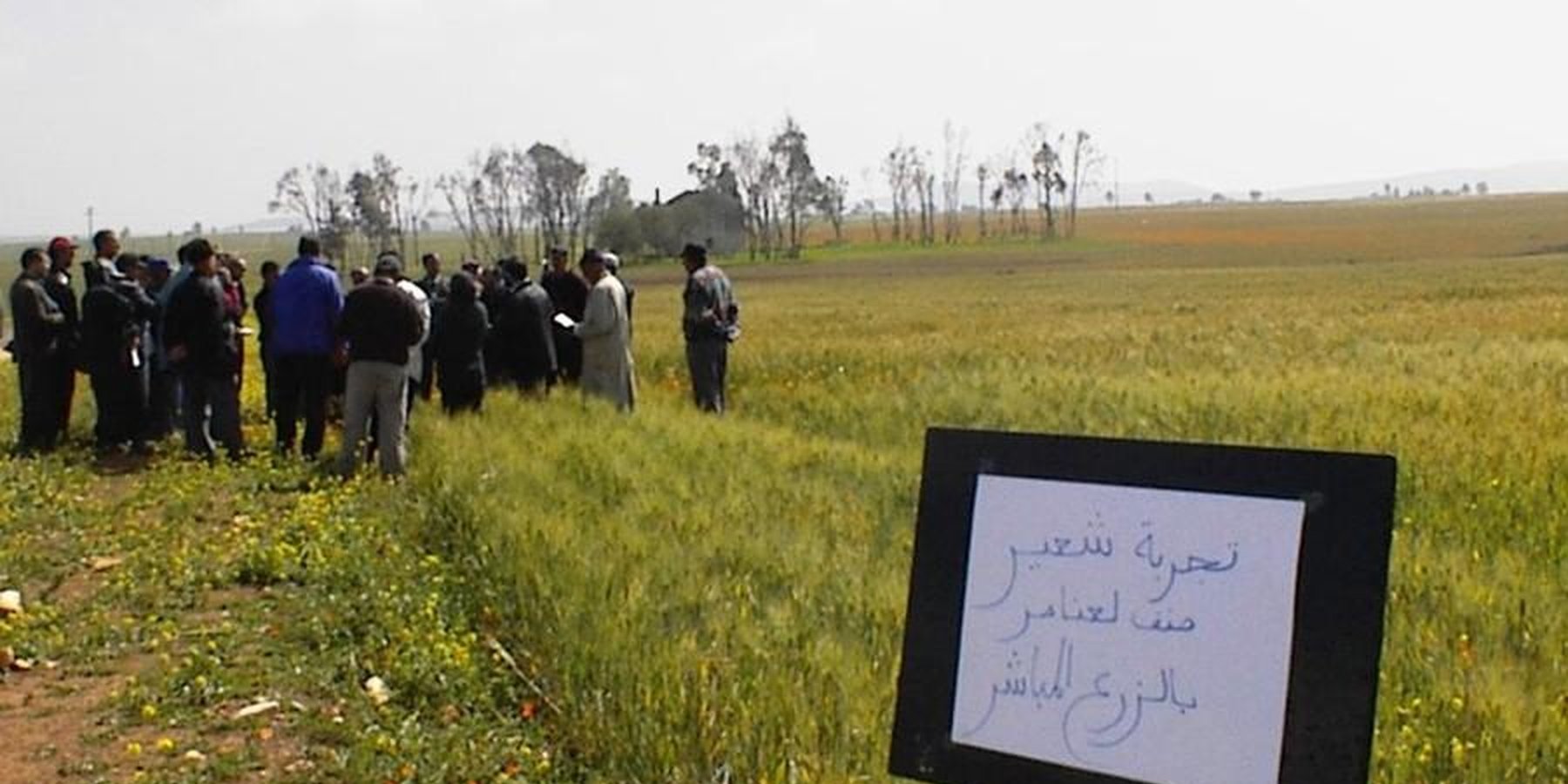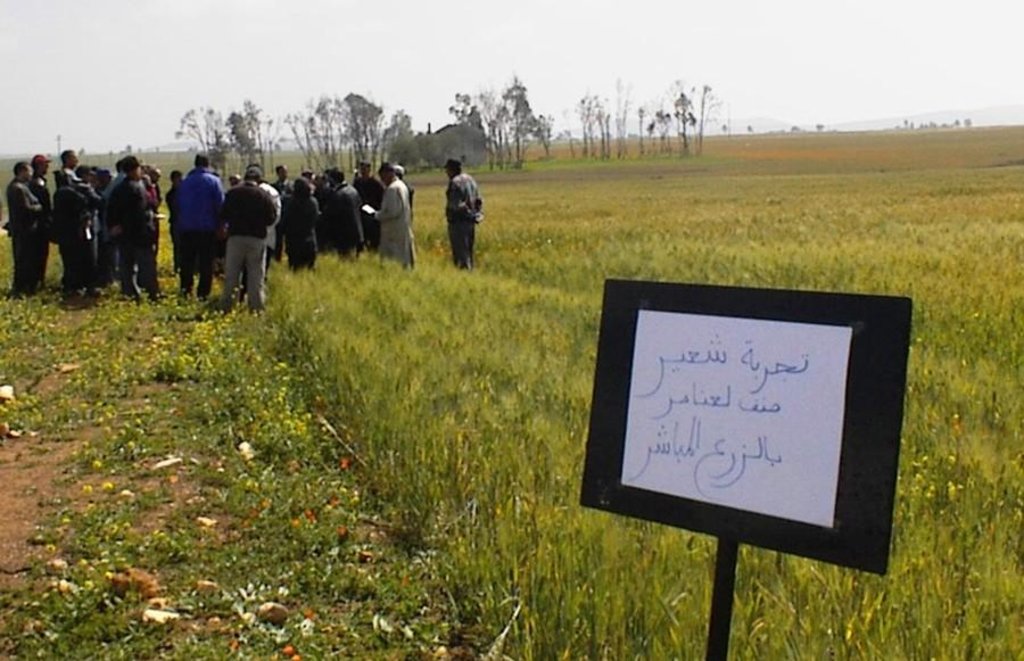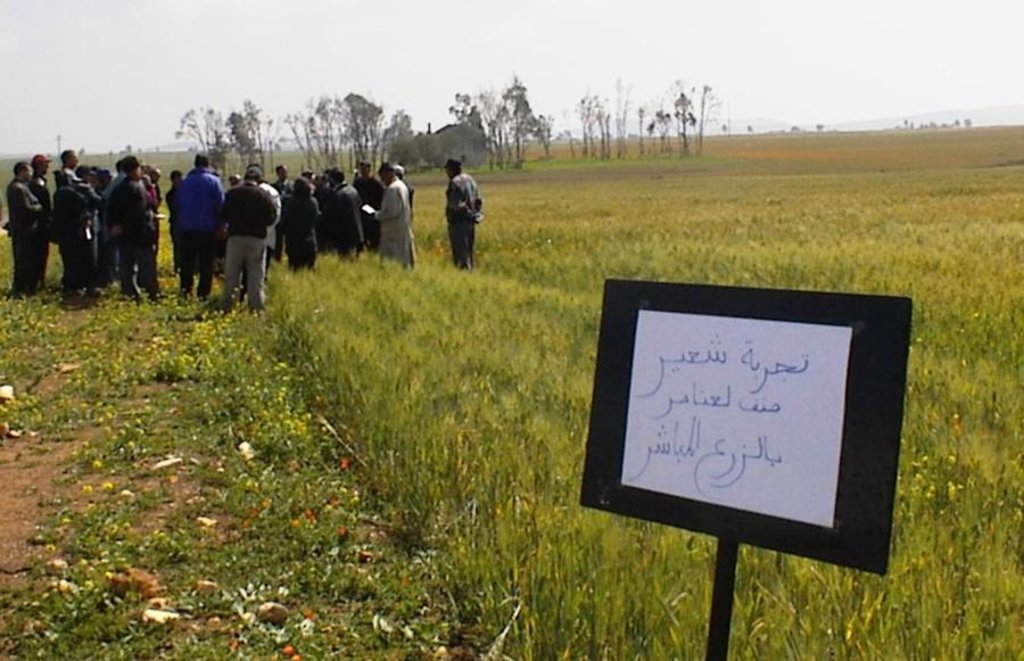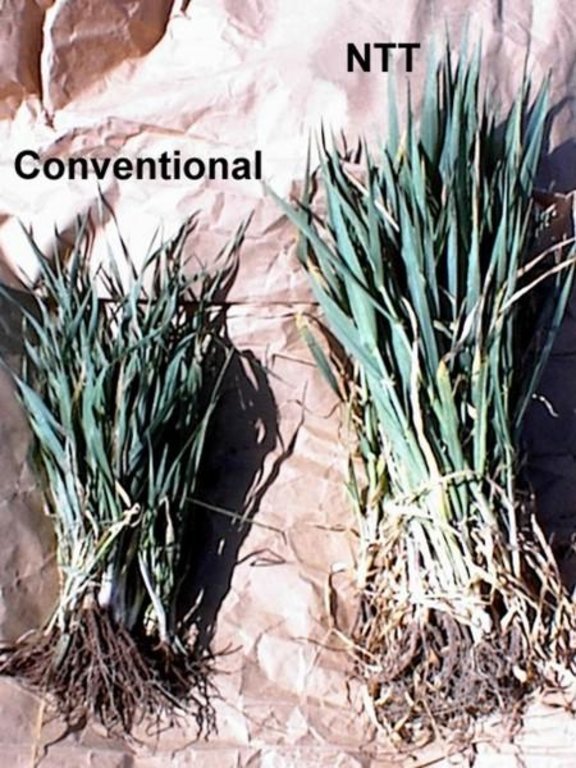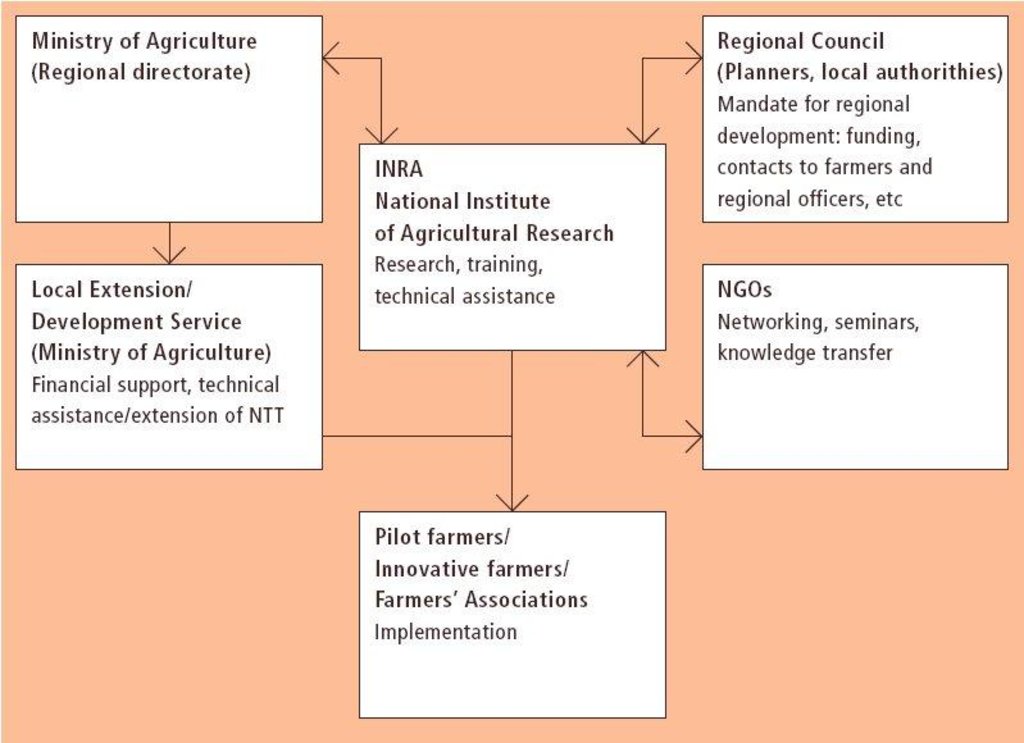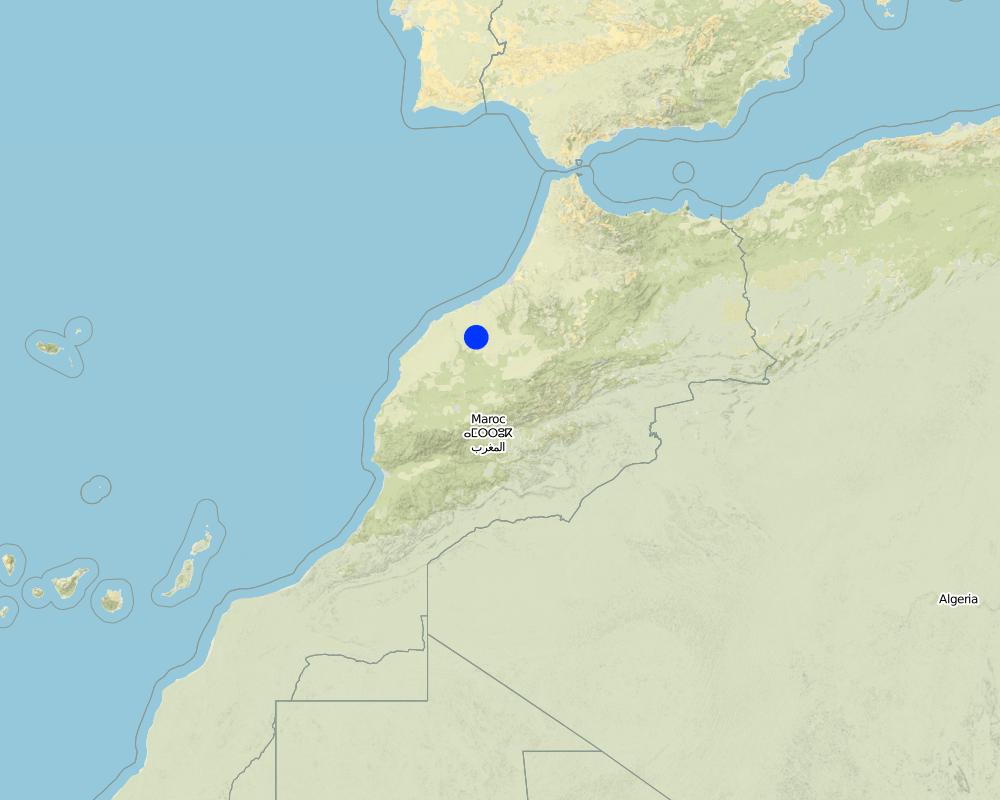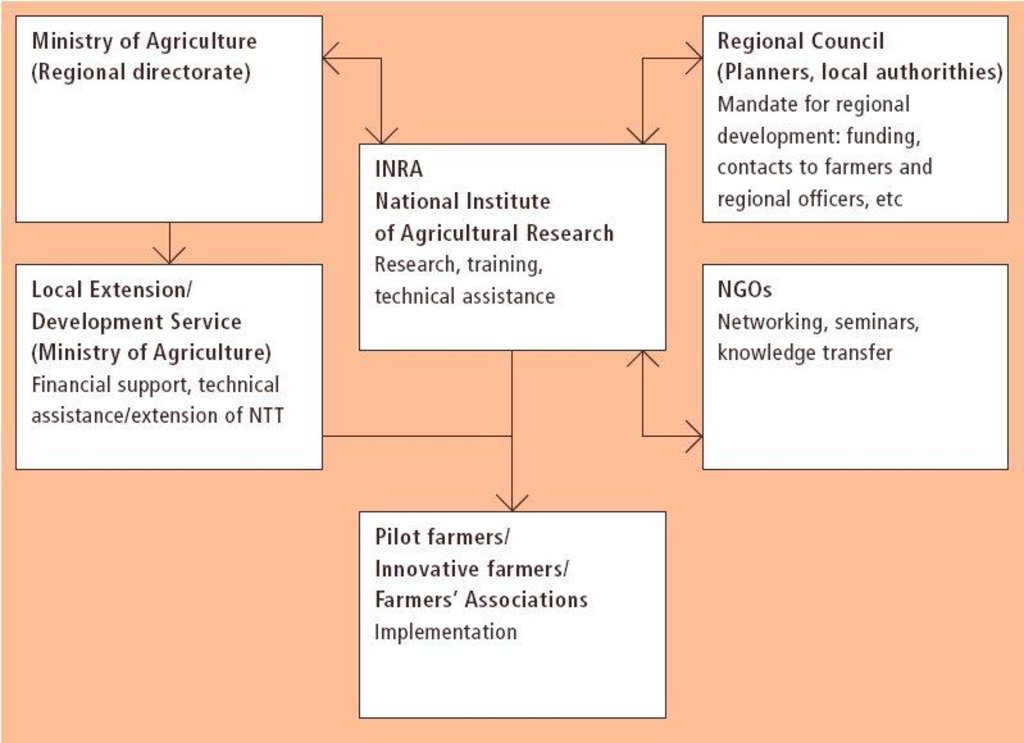Applied research and knowledge transfer [Morocco]
- Creation:
- Update:
- Compiler: Rachid Mrabet
- Editor: –
- Reviewers: David Streiff, Alexandra Gavilano, Deborah Niggli
approaches_2355 - Morocco
View sections
Expand all Collapse all1. General information
1.2 Contact details of resource persons and institutions involved in the assessment and documentation of the Approach
Name of project which facilitated the documentation/ evaluation of the Approach (if relevant)
Book project: where the land is greener - Case Studies and Analysis of Soil and Water Conservation Initiatives Worldwide (where the land is greener)Name of the institution(s) which facilitated the documentation/ evaluation of the Approach (if relevant)
Institut National de la Recherche Agronomique Morocco (INRA-Morocco) - Morocco1.3 Conditions regarding the use of data documented through WOCAT
The compiler and key resource person(s) accept the conditions regarding the use of data documented through WOCAT:
Yes
1.4 Reference(s) to Questionnaire(s) on SLM Technologies
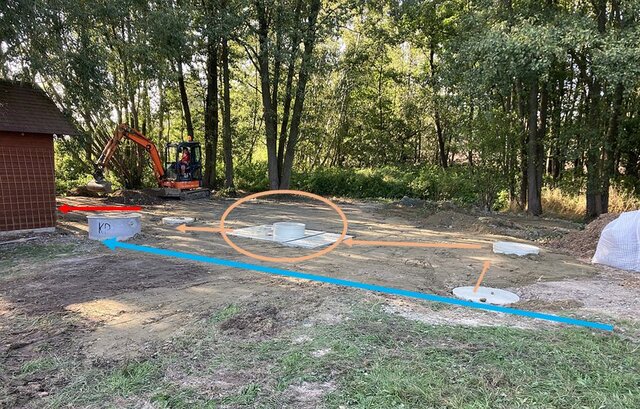
Drainage Biofilter [Czech Republic]
Biofilters or “bioreactors” connected to agricultural tile drains are relatively inexpensive and space-saving measures with considerable potential to improve the quality of drainage water.
- Compiler: Antonín Zajíček
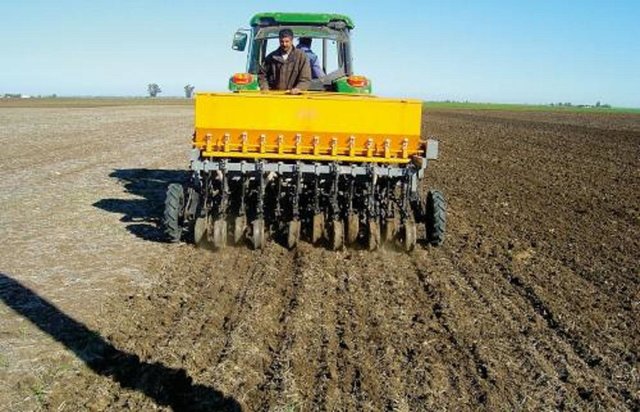
No-till technology [Morocco]
A no-till system with crop residue management for mediumscale wheat and barley farming.
- Compiler: Rachid Mrabet
2. Description of the SLM Approach
2.1 Short description of the Approach
Innovative, cross-disciplinary community-based approach for development and transfer of no-till technology at the farm level.
2.2 Detailed description of the Approach
Detailed description of the Approach:
Aims / objectives: After 15 years of on-station research at the National Institute of Agricultural Research (INRA), testing and evaluation of no-till technology (NTT) at farm level started in 1997 with three pilot farmers. Recently two new projects were established to promote the introduction and adoption of NTT, in collaboration with the regional council and extension service of the Ministry of Agriculture (MoA). Fourteen pilot farmers are now involved in NTT. The overall purpose is to promote no-till technology to restore soils, improve production, mitigate drought, increase wealth and strengthen farmers??? organisations. NTT has been shown to be socially, economically and ecologically adapted to the local conditions. The approach has three stages: (1) Initiation: this includes basic research, strategic research and applied research; (2) Consolidation: planning is followed by detailed evaluation of technology adoption on farmers' fields; (3) Maturity: this involves the acceptance/spread of NTT with an increased number of farmers in the future.
Methods: INRA carries out research, information dissemination, gives training to technicians and farmers, and provides both technical assistance and monitoring. The regional council was convinced by the technology and now financially supports research activities, drill manufacture and extension of NTT. It also facilitates contacts with decision makers and farmers, and carries out evaluations. MoA development and extension services provide financial support, advice, technical assistance, and logistical support to farmers: they help to make the drills available. NGOs are engaged in the development of local/regional networks and farmers associations, as well as in funding and providing incentives. Farmers themselves are involved in the implementation, evaluation and dissemination of NTT. Participation, cross-discipline and bottom-up planning are key elements of the approach. Methods for implementation include long-term community on-farm trials, on-site training and information exchange, participation of stakeholders, information dissemination tools, and multi-directional knowledge flow. These are supplemented by intensive measurement/monitoring schemes, establishment of local/regional networks and farmers' association creation. On-the-job training is also provided.
2.3 Photos of the Approach
2.5 Country/ region/ locations where the Approach has been applied
Country:
Morocco
Region/ State/ Province:
Chaouia/Ouardigha
Map
×2.6 Dates of initiation and termination of the Approach
Indicate year of initiation:
1997
Comments:
The approach is now under application in this region but it is expected to apply in other regions of Morocco if funds are available
2.7 Type of Approach
- project/ programme based
2.8 Main aims/ objectives of the Approach
The Approach focused mainly on SLM with other activities
- spread the no-till technology: thereby enhancing soil productivity and reducing susceptibility to land degradation. - develop the production of no-till drill machinery. - generally: to ameliorate the living conditions of rural people through enhancing expertise, capacities and knowledge of farmers in managing their soils and crops
The SLM Approach addressed the following problems: - previous absence of an integrated research and extension programme. - lack of technical options in a harsh and risky environment. - underlying problems of land degradation and drought periods
2.9 Conditions enabling or hindering implementation of the Technology/ Technologies applied under the Approach
social/ cultural/ religious norms and values
- hindering
Over-reliance on traditions in soil management; attitudes of farmers towards conventional tillage need challenging through information about alternatives.
Treatment through the SLM Approach: Training, video conferences, travelling workshops, etc.
availability/ access to financial resources and services
- hindering
Lack of specific funds, credit, loans for investment in new machinery
Treatment through the SLM Approach: Prioritise funds for no-tillage development
institutional setting
- hindering
Extension service are not well incorporated in the approach due to lack of knowledge/information on no-tillage
Treatment through the SLM Approach: Special Training program; change of institutional thinking upon no-tillage systems
legal framework (land tenure, land and water use rights)
- hindering
lack of SWC-relatedl laws
Treatment through the SLM Approach: Recommendations on laws to cover SWC technologies.
The existing land ownership, land use rights / water rights moderately hindered the approach implementation small size of field requires integration of farmers for using no-till drill and other equipment
knowledge about SLM, access to technical support
- hindering
Lack of adapted machinery
Treatment through the SLM Approach: Promotion of no-till drill industry in Morocco
3. Participation and roles of stakeholders involved
3.1 Stakeholders involved in the Approach and their roles
- local land users/ local communities
- community-based organizations
Existing groups of land users
- SLM specialists/ agricultural advisers
- national government (planners, decision-makers)
INRA
3.2 Involvement of local land users/ local communities in the different phases of the Approach
| Involvement of local land users/ local communities | Specify who was involved and describe activities | |
|---|---|---|
| initiation/ motivation | passive | Mainly:public meetings; partly: workshops/seminars; open days |
| planning | external support | Mainly: workshops/seminars; partly: public meetings |
| implementation | external support | Mainly: responsibility for minor steps; partly: casual labour |
| monitoring/ evaluation | external support | Mainly: interviews/questionnaires; partly: measurements/observations; field observations |
| Research | interactive | on-farm; demonstration plots |
3.3 Flow chart (if available)
Description:
Institutional framework: Stakeholders and their roles: cross-disciplinary linkages between INRA, collaborating institutions and farmers.
3.4 Decision-making on the selection of SLM Technology/ Technologies
Specify who decided on the selection of the Technology/ Technologies to be implemented:
- mainly SLM specialists, following consultation with land users
Explain:
Recognition of no-tillage as a pertinent technology by decision-makers at local, regional or national level (specialists and politicians / leaders) is due to important station results as well as to international call for promoting this technology
Decisions on the method of implementing the SLM Technology were made by mainly by SLM specialists with consultation of land users. No-tillage technology was under research and on farm trials (3 farmers) and showed very marked benefits, particularly during droughty years
4. Technical support, capacity building, and knowledge management
4.1 Capacity building/ training
Was training provided to land users/ other stakeholders?
Yes
Specify who was trained:
- land users
- extensionists/trainers, politicians/decision makers, planners
Form of training:
- on-the-job
- demonstration areas
- public meetings
Subjects covered:
no-tillage system, weed control, machinery, cropping systems, crop variety
4.2 Advisory service
Do land users have access to an advisory service?
Yes
Specify whether advisory service is provided:
- on land users' fields
Describe/ comments:
Key elements: Participation of extension agents and farmers / observations (on the crop, weeds, disease, seeding condition, yield components), On-job training / open days (field days to make farmers and extension discuss questions / remarks regarding no till technology, Monitoring/Participatory; 1) Advisory service was carried out through: government's existing extension system 2) Advisory service was carried out through: government's existing extension system; Extension staff: mainly government employees 3) Target groups for extension: land users; Activities: demonstration, field days, traveling workshops
Advisory service is inadequate to ensure the continuation of land conservation activities; Extension Agents need training
4.3 Institution strengthening (organizational development)
Have institutions been established or strengthened through the Approach?
- yes, moderately
Specify the level(s) at which institutions have been strengthened or established:
- local
Specify type of support:
- financial
- capacity building/ training
4.4 Monitoring and evaluation
Is monitoring and evaluation part of the Approach?
Yes
Comments:
Bio-physical aspects were regular monitored by 0 through measurements
Technical aspects were regular monitored by 0 through measurements
Socio-cultural aspects were ad hoc monitored by 0 through observations
Economic / production aspects were regular monitored by 0 through measurements;
Area treated aspects were ad hoc monitored by 0 through observations
No. of land users involved aspects were regular monitored by 0 through measurements
Management of Approach aspects were ad hoc monitored by 0 through observations;
There were no changes in the Approach as a result of monitoring and evaluation: The evaluation is still in process: thus too early to state what changes are likely.
4.5 Research
Was research part of the Approach?
Yes
Specify topics:
- sociology
- technology
- agronomy
Give further details and indicate who did the research:
crop performance, soil analysis, no-till drill design and evaluation, socio-economic indexes of NTT.
Research was carried out both on station and on-farm
5. Financing and external material support
5.1 Annual budget for the SLM component of the Approach
If precise annual budget is not known, indicate range:
- 100,000-1,000,000
Comments (e.g. main sources of funding/ major donors):
Approach costs were met by the following donors: government (national - INRA/Ministry): 80.0%; local community / land user(s) (Regional Council): 20.0%
5.2 Financial/ material support provided to land users
Did land users receive financial/ material support for implementing the Technology/ Technologies?
Yes
5.3 Subsidies for specific inputs (including labour)
- equipment
| Specify which inputs were subsidised | To which extent | Specify subsidies |
|---|---|---|
| machinery | fully financed | |
- agricultural
| Specify which inputs were subsidised | To which extent | Specify subsidies |
|---|---|---|
| fully financed | ||
| fully financed | ||
| biocides | fully financed | |
If labour by land users was a substantial input, was it:
- voluntary
5.4 Credit
Was credit provided under the Approach for SLM activities?
Yes
Specify conditions (interest rate, payback, etc.):
repayment conditions: To promote the acceptance of the technology, farmers receive a 50% subsidy on the purchase price of the no-till drill (as is the general case for all types of drills)..
6. Impact analysis and concluding statements
6.1 Impacts of the Approach
Did the Approach help land users to implement and maintain SLM Technologies?
- No
- Yes, little
- Yes, moderately
- Yes, greatly
Better use of the rainwater stored in the soil by crops leads to improvement of soil and water management: increase in soil organic matter has multiple benefits.
Did the Approach improve issues of land tenure/ user rights that hindered implementation of SLM Technologies?
- No
- Yes, little
- Yes, moderately
- Yes, greatly
The land is a private property and can not be affected by no-tillage but with no-tillage farmers can rent or buy new lands for adoption of more no-tillage.
Did other land users / projects adopt the Approach?
- No
- Yes, little
- Yes, moderately
- Yes, greatly
This no-till system can now be considered for several different agroecological situations where a similar approach can be applied (e.g. flood control project, agro-forestry program, soil restoration project, etc.).
6.3 Sustainability of Approach activities
Can the land users sustain what has been implemented through the Approach (without external support)?
- yes
If yes, describe how:
Progress can continue to be made, assuming that training, subsidised drills, and the creation of farmers' organisations all persist.
6.4 Strengths/ advantages of the Approach
| Strengths/ advantages/ opportunities in the land user’s view |
|---|
| Adaptability to farmers needs/constraints (How to sustain/ enhance this strength: Include integration of livestock and crops. This should be helpful to pursue in the approach) |
| Farmer's decisions, opinions, critics (How to sustain/ enhance this strength: Bottom-up maintained (gradually)) |
| Incentives make it possible for land users to experiment with a new cultivation system (How to sustain/ enhance this strength: Diversification of incentives: eg reduction in seed prices and herbicides for NTT farmers; award - NTT best producers; reduction in interest rates for NTT farmers (for credits or loans); special NTT training courses.) |
| Strengths/ advantages/ opportunities in the compiler’s or other key resource person’s view |
|---|
| The NTT project has integrated several institutions -which is unique in Morocco. Now research, extension, community and farmers are working together towards the same objective (How to sustain/ enhance this strength: Further develop, refine and spread NTT) |
| NGOs development: the association of NTT farmers and environmental clubs are important for spreading NTT and for re-enforcing the importance of NTT amongst government officers and decision makers (How to sustain/ enhance this strength: special NGOs should be encouraged to respect soils, nature, environment) |
| Cross-discipline: involving land users, research and extension agents has helped in building up an approach suitable for the local conditions. (How to sustain/ enhance this strength: The working teams received also incentives and recognictions) |
| research connected to extension (How to sustain/ enhance this strength: research should be developed to get continuous measurements/information and to search new indexes and means) |
| Progressive implementation of a 'bottom-up' approach; integration of farmers' decisions, opinions and criticisms (How to sustain/ enhance this strength: Farmers and their association are involved gradually in the approach and their critics, comments, feedbacks respected) |
6.5 Weaknesses/ disadvantages of the Approach and ways of overcoming them
| Weaknesses/ disadvantages/ risks in the land user’s view | How can they be overcome? |
|---|---|
| Information availability: up to now information and communication on NTT is scarce | intensify training of trainees |
| In some situations (farmers with very low incomes), the need for external inputs such as herbicides, seeds, fertilizers and drills may retard implementation of NTT | Incentives should be maintained for a short period and supplemented by credit systems. |
| Weaknesses/ disadvantages/ risks in the compiler’s or other key resource person’s view | How can they be overcome? |
|---|---|
| Direct incentives: there is always a risk that when eliminating these incentives, farmers will abandon NTT | Eliminate incentives gradually and replace with loans and credits. |
| The programme's duration is currently too short to overcome resistance (to new technology adoption) and to address economic constraints of farmers | A long term programme is needed to increase acceptance among farmers. |
7. References and links
7.1 Methods/ sources of information
- field visits, field surveys
- interviews with land users
7.2 References to available publications
Title, author, year, ISBN:
Wall et al, 2002, Institutional aspects of conservation agriculture, International workshop on conservation agriculture for sustainable wheat production, 14-18, october 2002, Tastikent, Usbekistan
Available from where? Costs?
p.wall@cgiar.org
Title, author, year, ISBN:
Segry, L.; Bouzinac, S and Pieri, C. 1991: An Approach to the development of sustainable farming systems. World echnical papaer N-2, ISBRAM proceedings 1991
Links and modules
Expand all Collapse allLinks

Drainage Biofilter [Czech Republic]
Biofilters or “bioreactors” connected to agricultural tile drains are relatively inexpensive and space-saving measures with considerable potential to improve the quality of drainage water.
- Compiler: Antonín Zajíček

No-till technology [Morocco]
A no-till system with crop residue management for mediumscale wheat and barley farming.
- Compiler: Rachid Mrabet
Modules
No modules


